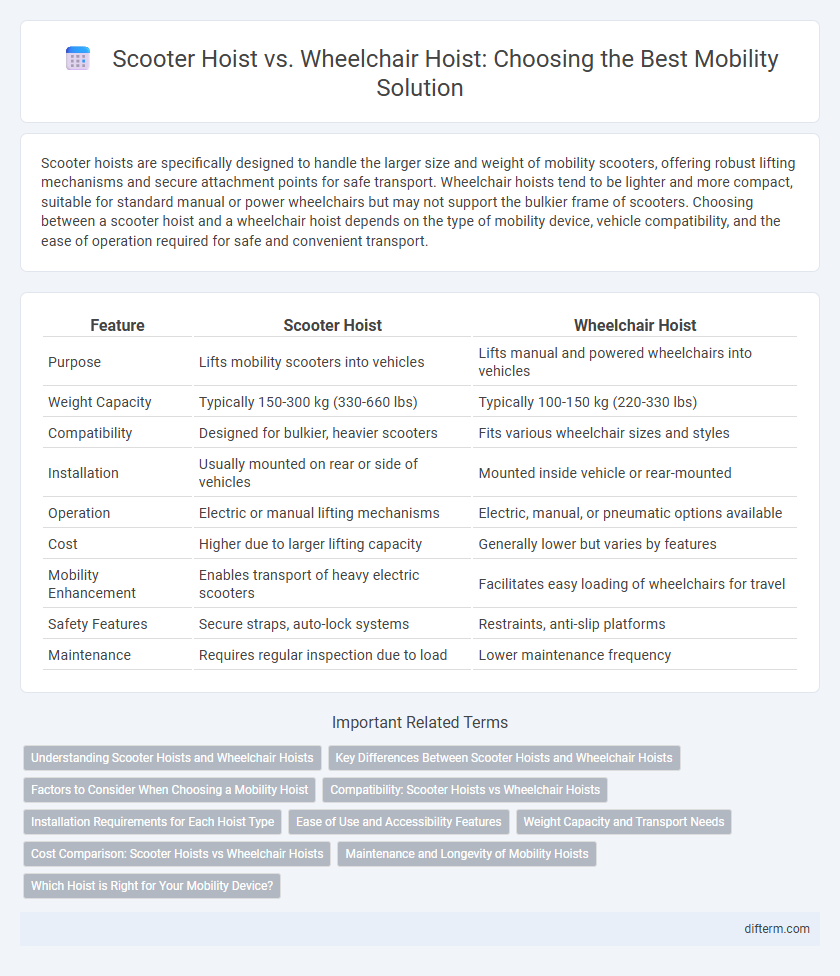Scooter hoists are specifically designed to handle the larger size and weight of mobility scooters, offering robust lifting mechanisms and secure attachment points for safe transport. Wheelchair hoists tend to be lighter and more compact, suitable for standard manual or power wheelchairs but may not support the bulkier frame of scooters. Choosing between a scooter hoist and a wheelchair hoist depends on the type of mobility device, vehicle compatibility, and the ease of operation required for safe and convenient transport.
Table of Comparison
| Feature | Scooter Hoist | Wheelchair Hoist |
|---|---|---|
| Purpose | Lifts mobility scooters into vehicles | Lifts manual and powered wheelchairs into vehicles |
| Weight Capacity | Typically 150-300 kg (330-660 lbs) | Typically 100-150 kg (220-330 lbs) |
| Compatibility | Designed for bulkier, heavier scooters | Fits various wheelchair sizes and styles |
| Installation | Usually mounted on rear or side of vehicles | Mounted inside vehicle or rear-mounted |
| Operation | Electric or manual lifting mechanisms | Electric, manual, or pneumatic options available |
| Cost | Higher due to larger lifting capacity | Generally lower but varies by features |
| Mobility Enhancement | Enables transport of heavy electric scooters | Facilitates easy loading of wheelchairs for travel |
| Safety Features | Secure straps, auto-lock systems | Restraints, anti-slip platforms |
| Maintenance | Requires regular inspection due to load | Lower maintenance frequency |
Understanding Scooter Hoists and Wheelchair Hoists
Scooter hoists and wheelchair hoists are mobility devices designed to assist in transporting mobility equipment, each tailored to specific weights and dimensions. Scooter hoists typically support heavier and bulkier mobility scooters, providing secure lifting mechanisms for vehicles up to 350 pounds. Wheelchair hoists are engineered for lighter loads, usually accommodating standard wheelchairs and powerchairs, with features optimized for ease of use and compact storage.
Key Differences Between Scooter Hoists and Wheelchair Hoists
Scooter hoists are specifically designed to accommodate larger, heavier mobility scooters with reinforced frames and higher weight capacities, while wheelchair hoists cater to lighter, more compact wheelchairs. Scooter hoists often require stronger mounting hardware and may incorporate motorized lifting mechanisms to handle increased loads. Wheelchair hoists prioritize ease of use and compactness, optimizing for smaller dimensions and lighter weight compared to scooter hoists.
Factors to Consider When Choosing a Mobility Hoist
When choosing between a scooter hoist and a wheelchair hoist, factors to consider include vehicle compatibility, weight capacity, and ease of use. Scooter hoists are designed to accommodate larger, heavier mobility devices with secure lifting mechanisms, whereas wheelchair hoists typically handle lighter, more compact wheelchairs. Space availability in the vehicle and the frequency of use are critical for determining the most suitable hoist type for optimal mobility assistance.
Compatibility: Scooter Hoists vs Wheelchair Hoists
Scooter hoists are specifically designed to accommodate the larger dimensions and heavier weight of mobility scooters, ensuring secure transport without compromising vehicle space. Wheelchair hoists typically support lighter and smaller manual or powered wheelchairs, offering greater compatibility with a wider range of vehicle types. Understanding the compatibility differences is crucial for selecting the appropriate hoist that matches the size, weight, and operational needs of the mobility device.
Installation Requirements for Each Hoist Type
Scooter hoists typically require reinforced mounting points and more clearance due to the larger size and weight of scooters compared to wheelchairs. Wheelchair hoists often demand more compact installation spaces with secure harness or clamp systems to ensure stability during transport. Both hoist types need electrical power connections, but scooter hoists may require higher amperage to handle their increased load capacity.
Ease of Use and Accessibility Features
Scooter hoists often require less manual effort due to automated lifting mechanisms, enhancing ease of use compared to traditional wheelchair hoists, which may need more physical handling. Accessibility features in scooter hoists typically include adjustable platforms and remote controls, allowing users with limited mobility to operate them independently. Wheelchair hoists, while functional, may have simpler designs that lack these advanced accessibility enhancements, making scooter hoists a preferred option for users seeking convenience and autonomy.
Weight Capacity and Transport Needs
Scooter hoists typically offer higher weight capacity, ranging from 300 to 600 pounds, accommodating larger mobility devices compared to wheelchair hoists, which generally support up to 350 pounds. Transport needs vary as scooter hoists require more clearance and robust mounting systems due to the bulkier size and heavier weight of scooters. Choosing between the two depends on vehicle compatibility, ease of loading, and the specific weight and dimensions of the mobility device.
Cost Comparison: Scooter Hoists vs Wheelchair Hoists
Scooter hoists generally have a higher upfront cost compared to wheelchair hoists due to their larger size and weight capacity requirements. Maintenance expenses for scooter hoists are also typically greater, reflecting more complex mechanical components and stronger lifting mechanisms. Choosing between scooter and wheelchair hoists depends on budget constraints and specific mobility device compatibility, with scooter hoists demanding a higher investment overall.
Maintenance and Longevity of Mobility Hoists
Scooter hoists and wheelchair hoists differ significantly in maintenance demands and longevity due to their structural designs and usage patterns. Scooter hoists typically require more frequent mechanical inspections and battery checks because of the heavier weight and complex motor systems, impacting their overall lifespan. Wheelchair hoists, designed for lighter loads and simpler mechanisms, generally offer longer service intervals and enhanced durability with routine maintenance.
Which Hoist is Right for Your Mobility Device?
Choosing the right hoist for your mobility device depends on the specific requirements of your scooter or wheelchair, including weight, size, and ease of use. Scooter hoists are designed to handle heavier weight and larger dimensions, often featuring strong lifting mechanisms compatible with motorized scooters. Wheelchair hoists tend to be more compact and lightweight, ideal for manual or powered wheelchairs, ensuring safe and efficient transport without damaging the device.
scooter hoist vs wheelchair hoist Infographic

 difterm.com
difterm.com